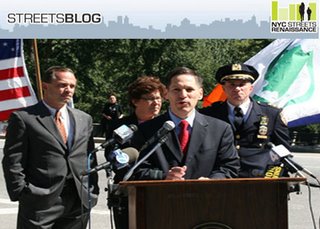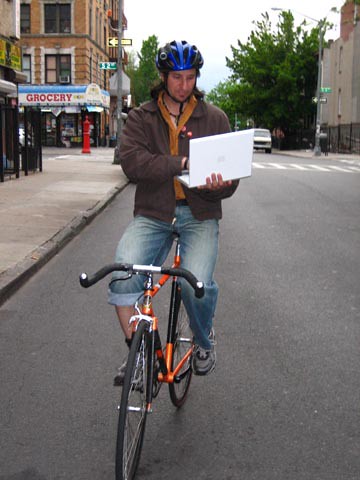200 miles of BIKE LANES! completed by 20(??)
But hey, its progress.
NY TIMES ARTICLE
City Hall Promises Major Increase in Bike Lanes on Streets
By WILLIAM NEUMAN
Published: September 13, 2006
The Bloomberg administration plans to greatly increase the number of bicycle
lanes after a city study showed that 225 cyclists died in accidents on city
streets over the last 10 years, officials said yesterday.
While some motorists may grumble that bike lanes take up road space and add
to congestion, the study suggests that the lanes actually work. Most of the
bike deaths involved crashes with cars, trucks or buses, but only one of
those involved a cyclist who was in a marked bike lane.
The city’s transportation commissioner, Iris Weinshall, said 200 additional
miles of bike lanes were planned for the five boroughs over the next three
years. The city now has about 220 miles of roadway designated for bikes,
including paths set off from vehicle traffic by barriers, lanes painted on
the street and routes indicated mainly by street signs.
“The data demonstrates cyclists need more safe places to ride,” Ms.
Weinshall said.
The highest toll in the last 10 years was 40 in 1999 and the lowest 13 in
2001. Last year 24 cyclists were killed, according to the study, which
compiled data from 1996 through 2005 and was conducted by several city
agencies.
Despite the city’s frenetic pace and heavy traffic, the study found that
riding a bicycle in New York City did not appear to be significantly more
deadly than in the country as a whole.
Based on the city’s population, there were 2.8 bicycle deaths a year per
million residents during the 10 years, slightly more than the
2.7-per-million rate nationwide.
“Simply encouraging more people to ride bikes is going to improve the safety
of cyclists,” said Noah Budnick, a deputy director of Transportation
Alternatives, a cycling advocacy group. He called the study and the bike
lane expansion “unprecedented.”
“The more people bike, the more drivers become accustomed to looking for
cyclists and to driving safely around them,” he said.
Nonetheless, there was some disagreement over how extensive the city’s
network of bike lanes really is — and will be after the expansion — because
of how the city calculates the mileage. If both sides of a one-mile strip of
a two-way street have bike lanes, for example, the city counts it as two
miles of bike lanes. Mr. Budnick said the city’s claim of 220 miles might be
more properly counted as less than half that. The same could be expected to
apply, he said, to much of the proposed new mileage.
The study revealed some intriguing trends. Men and boys accounted for 91
percent of the toll, or 199 fatalities. That was similar to data for the
country as a whole, where male cyclists make up 89 percent of fatalities.
Thomas R. Frieden, the health commissioner, said the predominance of men and
boys among the fatalities might reflect “a little bit more risk-taking
behavior from males.”
Crashes with moving vehicles accounted for 207 of the deaths in the study.
Among those, nearly a third involved trucks and buses, although they are
only about 15 percent of the vehicles on city streets.
The trend was the opposite for taxis. Cyclists accustomed to cursing at cabs
as the drivers dart through Midtown traffic might be surprised to learn that
taxis accounted for only two of the vehicle-bike deaths, or 1 percent,
although cabs make up 2 percent of registered vehicles in the city.
The study also reinforced the importance of wearing a bike helmet. It found
that 74 percent of fatal accidents involved head injuries and that, in cases
in which records on helmet use were kept, 97 percent of the riders who died
were not wearing one.
The study found that cyclists’ ignoring traffic controls like lights and
stop signs was one of the most common factors contributing to fatal
accidents. Drivers not paying attention was another common factor.
The city plans to start an advertising campaign next spring to remind
drivers and bike riders about safety.
---------------------------------
Photo by: Graham Beck, Transportation Alternatives
New York City Department of Health Commissioner Thomas Frieden speaking at yesterday's event (9/12/06) in Central Park announcing a major new bicycle safety initiative. Behind him, from left to right, are Parks Commissioner Adrian Benepe, Transportation Commissioner Iris Weinshall, and NYPD Chief of Transportation Michael Scagnelli

Meanwhile streetsblog has been covering the story. Scroll through the last few entrys on this very informative blog and find out things like the city is now treating bicycling as a public health issue...its about time. Bloomberg with his ending of smoking inside and his name being on a major public health school. How many people have to be crushed on their bikes by giant trucks who don't look before the city wakes up?
With the annoucement of the new plan on bike lanes the city released a press relase which includes facts like this:
Bicycle lanes and helmets may reduce the risk of death.
Almost three-quarters of fatal crashes (74%) involved a head injury.
Nearly all bicyclists who died (97%) were not wearing a helmet.
Helmet use among those bicyclists with serious injuries was low (13%), but it was even lower among bicyclists killed (3%).
Only one fatal crash with a motor vehicle occurred when a bicyclist was in a marked bike lane
Nearly all bicyclist deaths (92%) occurred as a result of crashes with motor vehicles.
Large vehicles (trucks, buses) were involved in almost one-third (32%) of fatal crashes, but they make up approximately 15% of vehicles on NYC roadways.
Most fatal crashes (89%) occurred at or near intersections.
Nearly all (94%) fatalities involved human error. All New Yorkers, whether pedestrians, bicyclists or motorists, can help prevent crashes by following traffic signs and signals and respecting other road users











8 Comments:
Joint Presentation
AIANY Planning & Urban Design Committee
AIANY Transportation & Infrastructure Committee
Friday September 15 2006 8-9:30 AM
Center for Architecture
NEW TRANSPORTATION INITIATIVES: ISSUES AND OPPORTUNITIES
AIANY has signed on to support an emerging coalition to study options for a
reduction in automobile impacts on the city. What are the city-wide
implications of achieving a 15% reduction In traffic? What are the benefits
(and costs) of congestion pricing as a strategy to achieve this? What are
potential impacts and can they be mitigated?
A presentation by sponsors of the initiative will be followed by a panel and
audience discussion.
Presentation:
Neysa Pranger, Campaign Coordinator, NYPIRG (NY Public Interest Research
Group) Paul White, Executive Director, Transportation Alternatives
The tv news reports this morning indicated that the city may make wearing a helmet the law. While wearing a helmet is a smart thing to do, studies have shown (sorry I don't have a link, google it if you must) that mandating helmet use has the effect of decreasing overall bicycle use. Rather than making helmets mandatory, wouldn't it be better to educate everyone so that cyclists & drivers behave in ways that are safer? Just a thought.
I did just come across this:
http://www.cyclelicio.us/2006/09/new-research-shows-wear-helmet-get-hit.html
Dr. Ian Walker has done study that show that cars pass closer to a cyclist if the biker is wearing a helmet. hmm...
I am a pedicab driver. there wqas a HUGE ticket blitz today for us. more than half of the drivers I spoke to got tickets. We are probably talking about 100+ tickets. I personaly got a ticket for not ridding in the bike lane. the biek lane in question was filled with wooden police blockades for fashion week. Also according to Iris Weinshall president of the DOT she doesn;t want pedicabs in the bike lane at all.
What does this mean? Will the NYPD stop harassing bicyclists and CM? Will BikeBlog finally become irrelevent when grousing about police misconduct against bicyclists? Or has the whole Bloomie Admin finally decided, if ya can't beat 'em, join 'em attitude? Give us the straight dope, BikeBlog!!!
The author of that Times artile needs a serious lesson in statistics.
Still, if the City's dealing with the idea of bike lanes, that's a good sign.
The helmet law is not a good sign.
How come most of the time when there's new policy that effects cyclists, it effects us negatively, taking something away or adding a new rule?
Anyway, thanks bikeblog for giving us the scoop.
I'm still not clear about your bicycle advocacy groups over there. Do you have any groups who participate in serious political lobbying? Bike blog has a lot of great articles about activism but it is often confrontational and that approach can cement a negative attitude from councils, police and the general public. You’ve probably already covered it in many posts that I haven’t read but it’d be great to know what legitimate efforts have been made to represent cyclists a political demographic group who’s require representation (First thing would have to be to show the fools that bikes can actually reduce traffic congestion!)
When I lived in Victoria Australia I rode a motorbike. Bikes had had a bad reputation for a long time but I found that a good relationship had been established between motorcyclists and the government and police. When I first went to the motorcycle grand prix in Philip Island I was astounded to find that police were actually courteous and obliging to motorcyclists, (maybe from fear of inciting some kind of riot?) the police gave bike riders a huge amount of freedom on the road and even allowed them to do break minor bylaws so that traffic could flow more freely. The result was that an attitude of cooperation became established, (nobody wanted to rock the boat when we were given so much freedom) Because so many were on bikes and there were far less cars there was probably a record number of people moved through some fairly narrow roads in record time. I think this approach totally changed the adversarial relationship between bike riders and police almost overnight. Cops weren’t there to book people but to maintain order and keep the traffic flowing. I don’t know which enlightened police came up with the idea but it really worked. Bikers felt they were respected as road users and I believe, on the whole, police would have come across far less agro from that time on.
We also had a TV advertising campaign reminding drivers that they share the road with motorcyclists. Part of the theme was “Look Left, Look Right, Look Bike.” People started to do it! I reckon even those adamantly biased against bike riders found themselves complying with the adds subliminal message that there are others on the road besides them.
I think that cyclists should be taken seriously as road users and deserve the same kind of awareness program that (I think) the Victorian Road Safety council managed to facilitate for motorcyclists. Damn it any conscientious town council or local/State government should be encouraging the use of bicycles! Imagine the problems it would solve…… (End of rant!)
David J: Transportation Alternatives does serious political lobbying. There are also more confrontational groups.
Post a Comment
<< Home